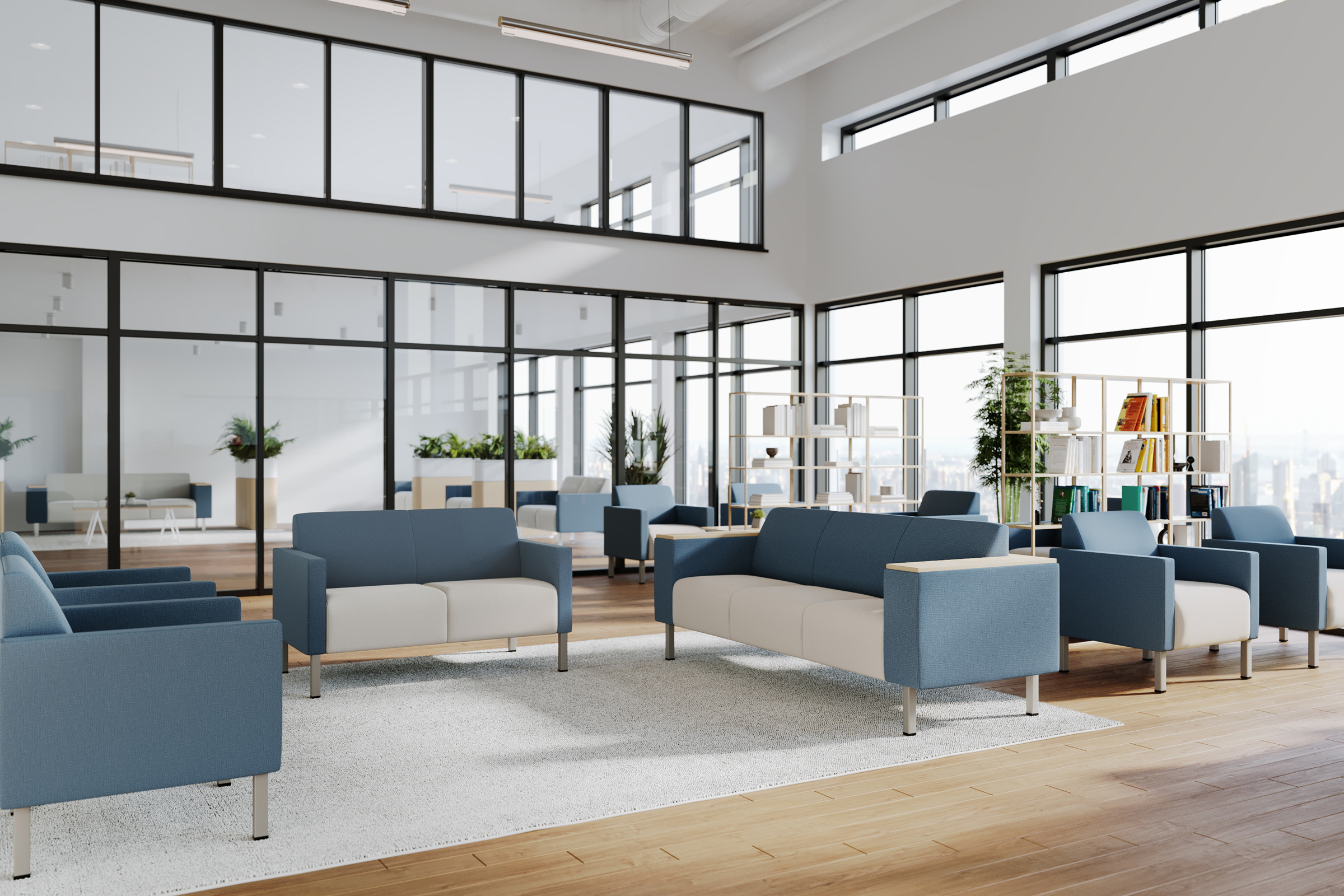Story at a glance:
- Comfort and control are becoming an evolving and integral part of health care design, including giving a feeling of control to patients.
- Cleveland Clinic continues to put patient and caregiver comfort at the forefront of its designs, from daylighting to places of respite.
For more than 100 years Cleveland Clinic has been setting the standard for patient care in clinical settings.
The nonprofit academic medical center has grown from a small outpatient clinic to nearly 300 locations with over 80,000 caregivers worldwide, adding up to 15 million patient visits per year. Travis Tyson has been with Cleveland Clinic for more than 17 years. He started as an architect in the planning and design department and now works as the director of planning and design. His team—more than a dozen employees—oversees all of the programming, planning, and design for the entire enterprise internationally. “Primarily we are here in Cleveland, but we oversee all 39 million square feet of our portfolio,” he says. “We are really proud of the work we do and the coordination between the clinicians, patients, and design team to create these built environments. It’s pretty exciting.”
The team is working on more than 1,200 active projects at any given time. A new Neurological Institute (NI) building is just one example; it’s currently being built on the main campus in Cleveland. “It’s one of the largest projects we’ve ever done. It’s just over a million square feet. That project itself is going to allow us to consolidate all of our NI services into one building on campus. Right now we’re spread out in about nine locations where patients may have to go.”
The project will dramatically expand the physical infrastructure dedicated to neurological care on the campus while consolidating inpatient and outpatient neurological care services. The design aims to maximize open spaces and natural light for ease of movement for patients. The NI project is scheduled to open in late 2026. It’s partly the result of feedback from Cleveland Clinic’s clinical users and physicians as well as patient focus groups. Cleveland Clinic also has an Office of Patient Experience and Office of Caregiver Experience that help inform design across facilities.
Across projects the Cleveland Clinic team is big on daylighting, Tyson says, especially as he says Cleveland is not exactly known for being sunny. “It’s important for our patients’ healing and even the mood of our caregivers.” The clinic’s new Mentor Hospital opened in 2023 makes great use of skylights, for example. “It really demonstrates how you can get natural light into a facility.”
The right LED lighting is an important supplement, too. Cleveland Clinic recently replaced all of its overhead lighting with LEDs. LED lighting in patient rooms can also have varying shades and brightness—giving control back to the patients. “Patients can change the color to help calm and relax them,” Tyson says.
Evolving Health Care Design
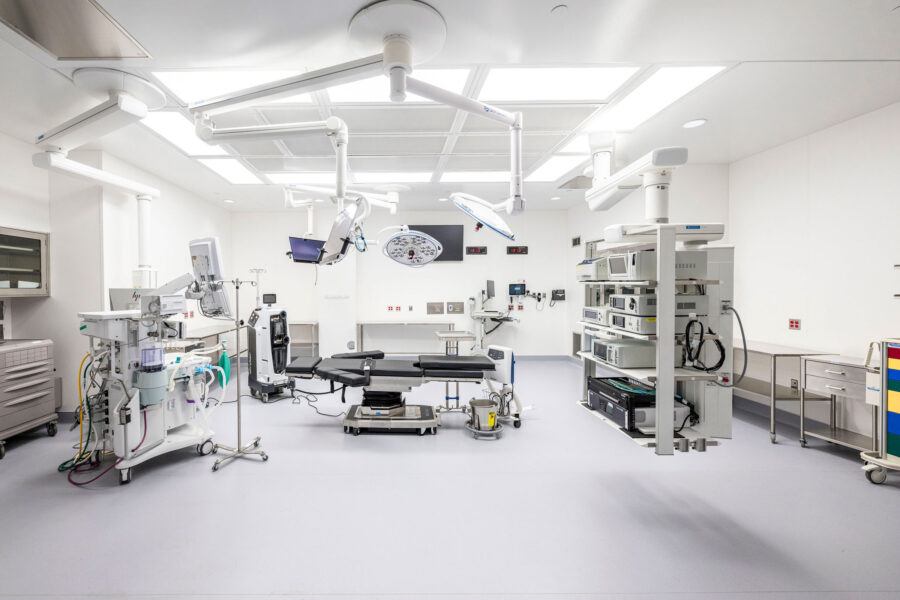
Mentor Hospital is Cleveland Clinic’s 23rd hospital and the first new hospital in northeast Ohio since Avon Hospital opened in 2016. Photo courtesy of Cleveland Clinic
Tyson says that while health care design has centered mainly on the patient for many years up until as recently as a decade ago, a high level of care and attention is now paid to every person who enters the building. Cleveland Clinic focuses on what’s best for patients, their families, and caregivers, too. “That’s just as important as the patients themselves because we want to make sure we take care of caregivers so they can give proper care to our patients,” he says.
Places where staff can rest, relax, and even emotionally heal after a traumatic event are a growing emphasis. More caregiver spaces are being rolled out across Cleveland Clinic inpatient facilities currently as part of a phased rollout. “We’re creating more respite spaces and ‘lavender lounges’ for caregivers.”
The clinic also continues to find ways to give patients back a feeling of control, Tyson says. “We ask: What do they want to control, and what would make them heal faster and better within their spaces? We have patient panel focus groups we talk to to get feedback, whether it’s their lighting controls, HVAC controls, or what they can order for food and how they order it,” he says.
Comforting Solutions in Health Care
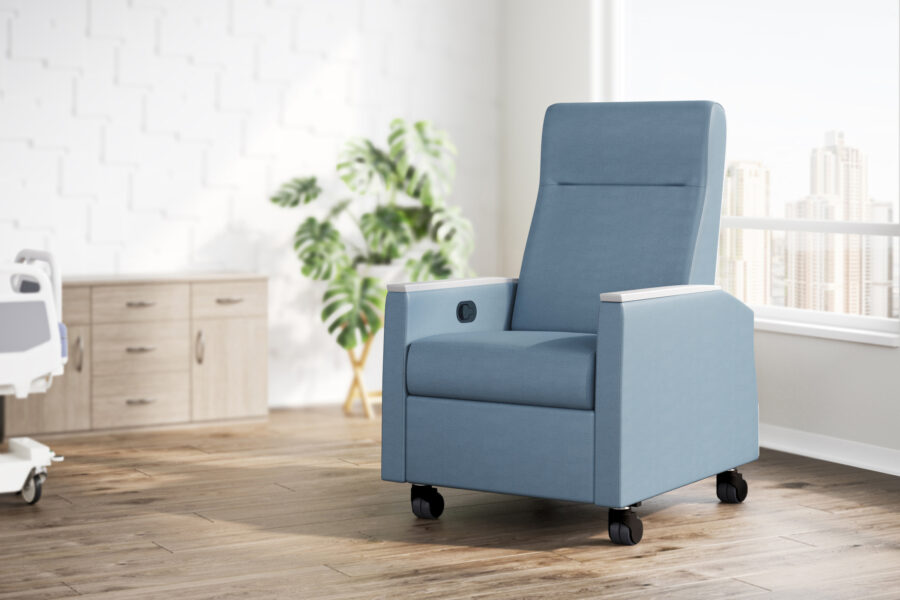
The Durable 650 Series. Photo courtesy of La-Z-Boy Healthcare, Knú Comfort
Comfort and control are also top concerns for another leader in the industry—La-Z-Boy Healthcare | Knú Comfort, whose designs include a growing series of patient room recliners and sleep sofas to make overnight stays for guests more comfortable when wanting to be near loved ones.
“Comfort is more than just a physical feeling of the occupant,” says Adam Stemle, vice president of sales and marketing at La-Z-Boy Healthcare | Knú Comfort. Stemle has been in the industry for more than 20 years and seen the evolution firsthand. “For us the physical comfort of the occupant or patient is a main driver, but we consider all aspects of comfort when designing our products. The comfort of the caregiver or nurse or doctor is an equally important driver on how and why we design specific products and features of the products.”
For example, seat height can be specified based on specific needs, providing added physical comfort to palliative patients to get into and out of a chair, as well as when it’s a higher seat height, the caregivers don’t have to bend down as much or endure physical strain while lifting or transferring patients from chair to bed or bed to chair. “Another aspect is the way our motion products are intuitive and don’t rely on a multi-page instruction or use guide on how to use these products,” Stemle says.
Comfort can be financial as well, he says, not only considering the competitive cost of these products in the market, but also how La-Z-Boy Healthcare | Knú Comfort designs products to last a long time and have field replaceable components and parts if something should happen. “When something happens to an infusion chair or oncology chair, that chair can be repaired onsite and back in service quick.”
Now you have all of that control in the power of a wand.
The Durable Series is La-Z-Boy Healthcare | Knú Comfort’s flagship, including the Durable 550, 650, 750, Durable Power, and Exam Lift solutions. This lineup includes the world’s first zero gravity recliners designed for health care applications, Stemle says, combining the company’s 50-plus years of recliner mastery with the latest technology to create the unexpected—a fully adjustable power recliner.
“That whole product line was designed to really provide a solution that took comfort to the next level, took intuitiveness to the next level. It took the recline handle and back recline pull off the chair, and it put all the chair’s function and motion into the patient’s or caregiver’s hand. That really revolutionized how that chair works,” Stemle says. “Now you’re not relying on physical action to open and push a chair back and do all of these functions. Now you have all of that control in the power of a wand.”
While he says there have been other power recline products in the marketplace, the Durable Power Series is the only one to offer multiple motors working together. “We’ve got three and four motors inside these chairs that are programmed to work together to provide positions like zero gravity, sleep, Trendelenburg, and home position on a preset. A zero gravity position is best achieved by taking as many pressure points off of your body by evenly distributing your weight and body angles with leg rest, seat angle, and back angle adjustments to eliminate pressure points during long-term sitting or treatment applications.”
Trusted aesthetics and comfort are key to the health care furniture of La-Z-Boy Healthcare | Knú Comfort, and the chairs themselves are intuitive, Stemle says, adding that they fill a void where durability is a must. “Most of the power products and recliner mechanisms in health care today are off-the-shelf mechanical products that some manufacturers will try to beef up in different ways to make them more durable or sustainable for the health care environment.”
The La-Z-Boy Healthcare | Knú Comfort offerings are built to take the daily abuse common in a health care environment, and new offerings also include lift assist and exam lift functions to raise the chair off the ground. “That’s really focused on caregivers not having to lift the patient out of the chair. Caregivers are asked to do so much in the facilities, and we are trying to bring products to address caregiver safety in addition to all the functionality that is needed in today’s health care environment,” Stemle says.
All Durable Series recliners feature a quick removable back that can come off for cleaning in seconds. Zero entrapment areas and the lift-up seat allow fast sanitization on every shift, too.
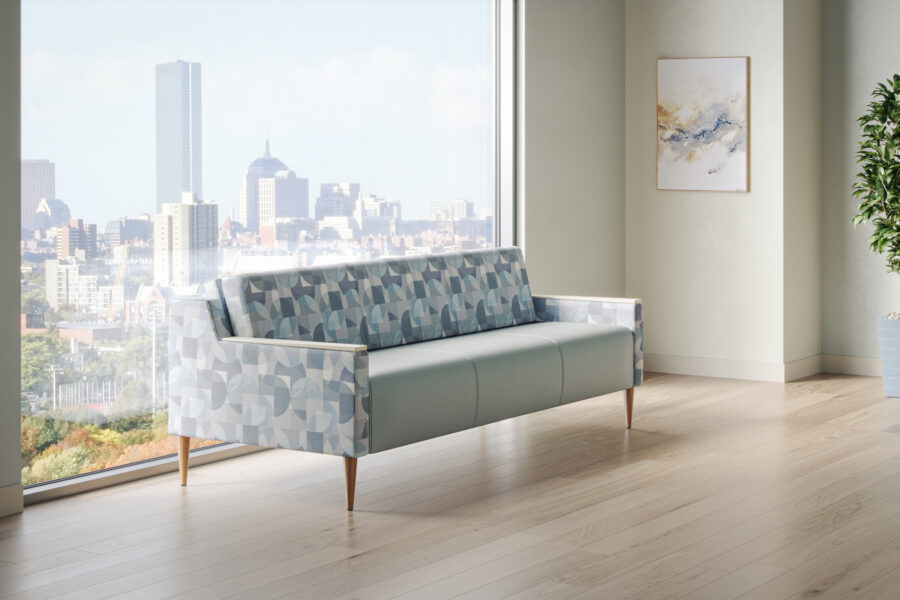
In its efforts to meet patient needs, La-Z-Boy Healthcare | Knú Comfort recently launched the Kenzley Sleep Sofa, combining aesthetics with cleanability and durability. Photo courtesy of La-Z-Boy Healthcare, Knú Comfort
In spring 2024 La-Z-Boy Healthcare | Knú Comfort launched its new Kenzley Sleep Sofa, an evolution of their other lines that makes keeping rooms and furniture clean even easier. Stemle says it’s important to have a product that doesn’t require you to put your hands anywhere you can’t see when you’re cleaning—especially considering there could be fluids or even sharp objects.
“We’re trying to integrate a lot of those cleanouts, a lot of that functionality, but the whole goal with everything, going back to the late ’90s, is to make it less institutional.” Modern furniture solutions should make patients feel as comfortable as possible and make for more inviting healing environments, Stemle says. La-Z-Boy Healthcare | Knú Comfort offers sleep sofas, sleep benches, pullout sleep sofas, and customizable options as part of a vast array of solutions that fit well in a variety of patient rooms, including labor and delivery and pediatric spaces.
“There are a lot of products being designed and developed in the last few years that are more than just a couch and a bed. You might have a couch with a table in the center of it that raises up so you can work or dine off of it or use it as a game table, but it’s still in that same footprint of sleep sofa so you’re maximizing your real estate in a patient room.”
Designing for the Future
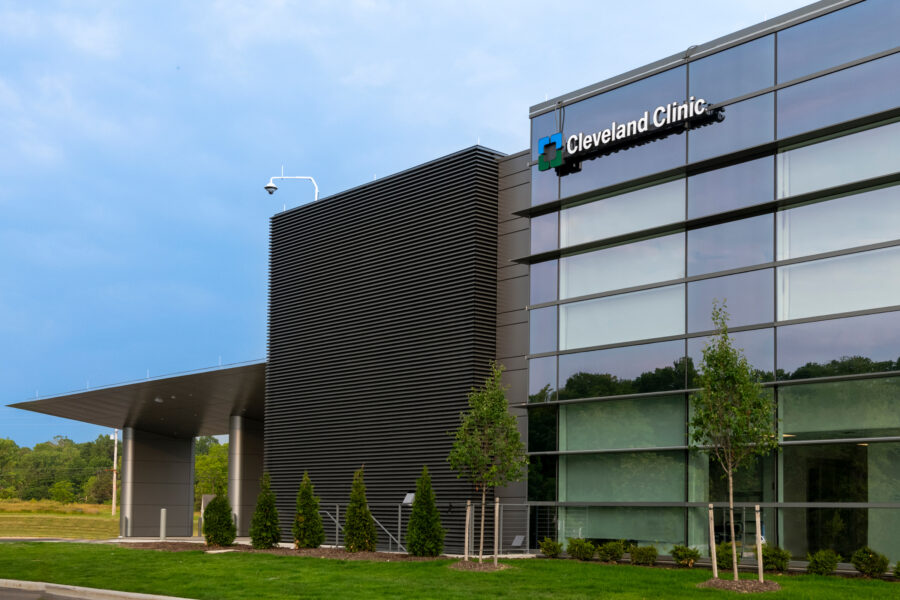
Cleveland Clinic’s Mentor Hospital opened in Ohio in 2023. Its modular design allows it to adapt in the future to meet changing needs. Photo courtesy of Cleveland Clinic
Maximizing real estate is a key goal at Cleveland Clinic. Given that the institution dates back more than a century, they’ve had to figure out how to grow from their original main campus over the decades. “Our footprint is fairly large on our main campus, but we don’t have a lot of other space to grow, so we have to think about: How do you best utilize your existing space, what’s the function of those spaces, and how do you use space in the most efficient way? One of the trends we’re seeing is converting administrative space or other types of space into clinical spaces to minimize the footprint of our administrative space,” Tyson says.
Tyson says planning and design is often centered around the idea of doing more in less space and with less money. “How can we convert or utilize our spaces differently in the future using technology?” he asks. What used to be considered futuristic is near, he thinks. “It could be integrating technology on the wall so it’s monitoring you as you come into a building and telling you where to go and removing all waiting rooms. It’s using your spaces differently so patients know exactly where to go. We talk about the future, but how do we implement ideas like that to change the footprint and change the layouts and designs of our spaces? I don’t know where we’re going to land, but I hear lots of conversation about all this cool stuff. We want to make sure we get it right before things are rolled out because of course we are dealing with people, but I think in the next few years things are going to change quite a bit.”

